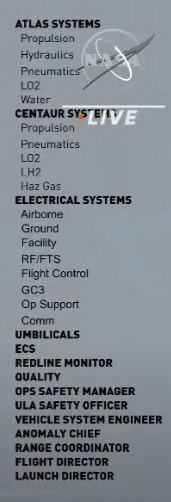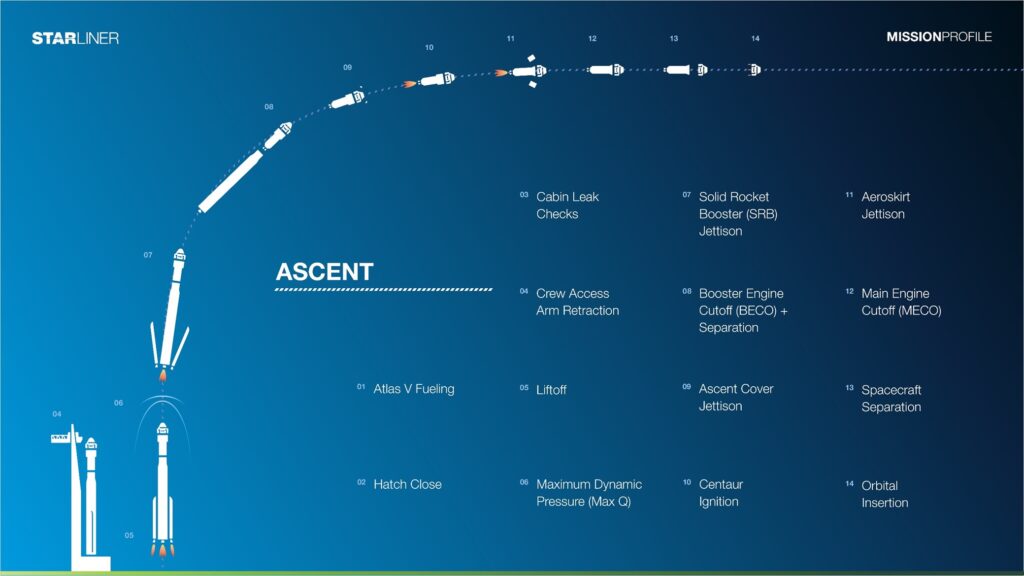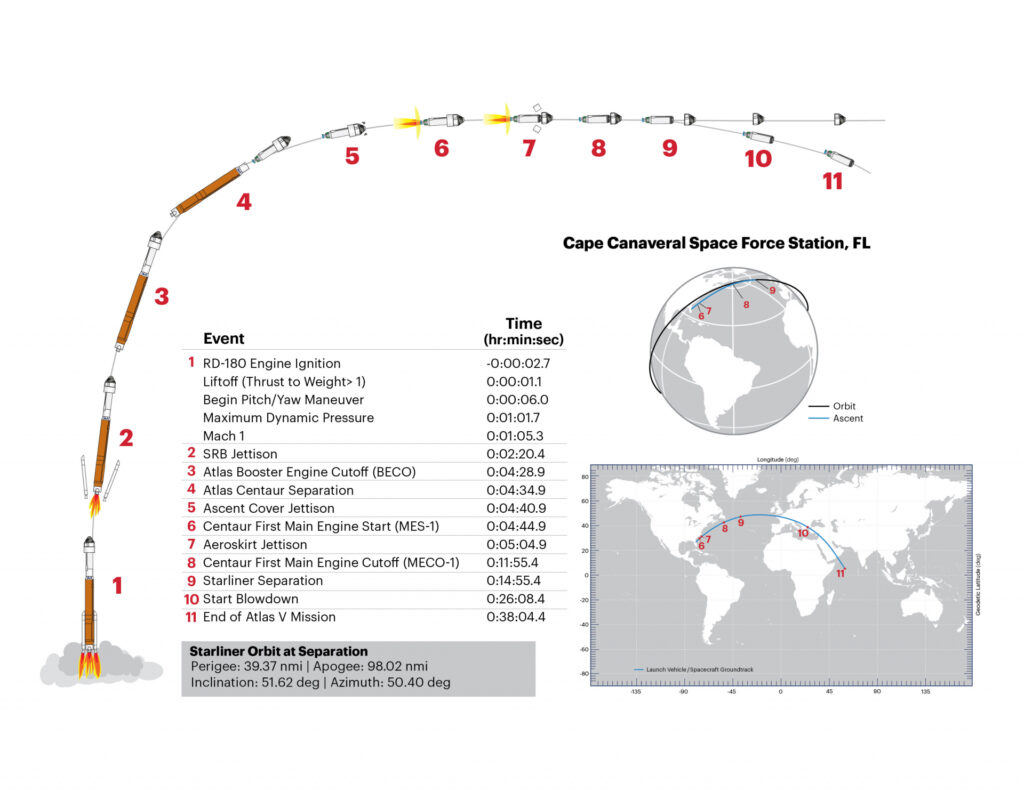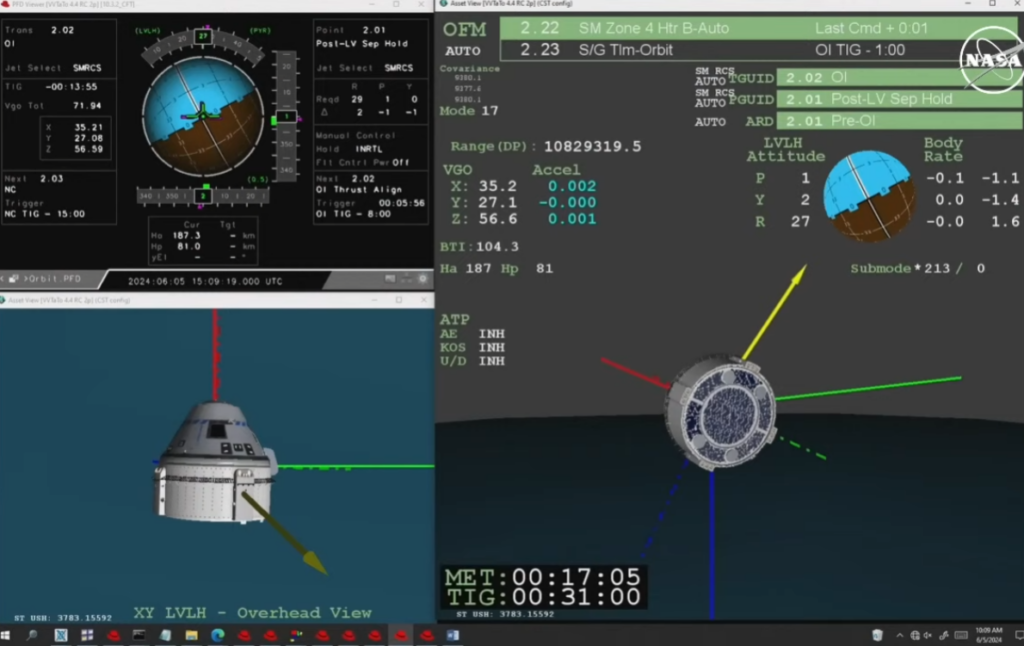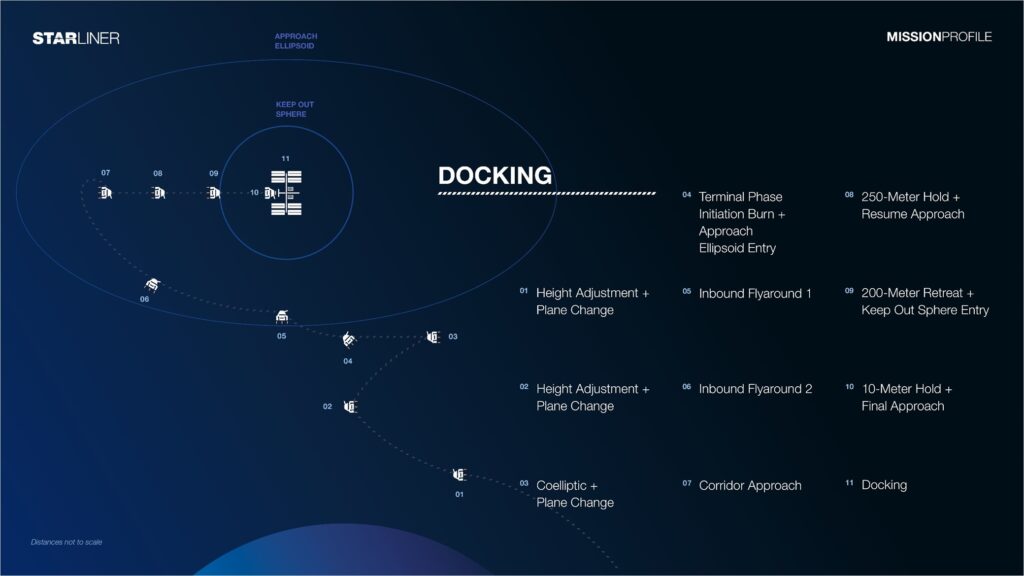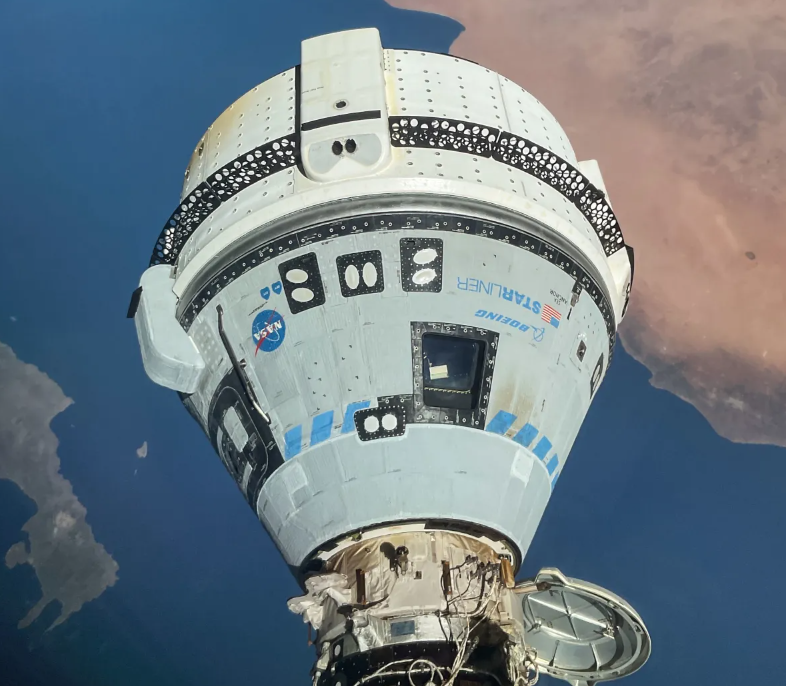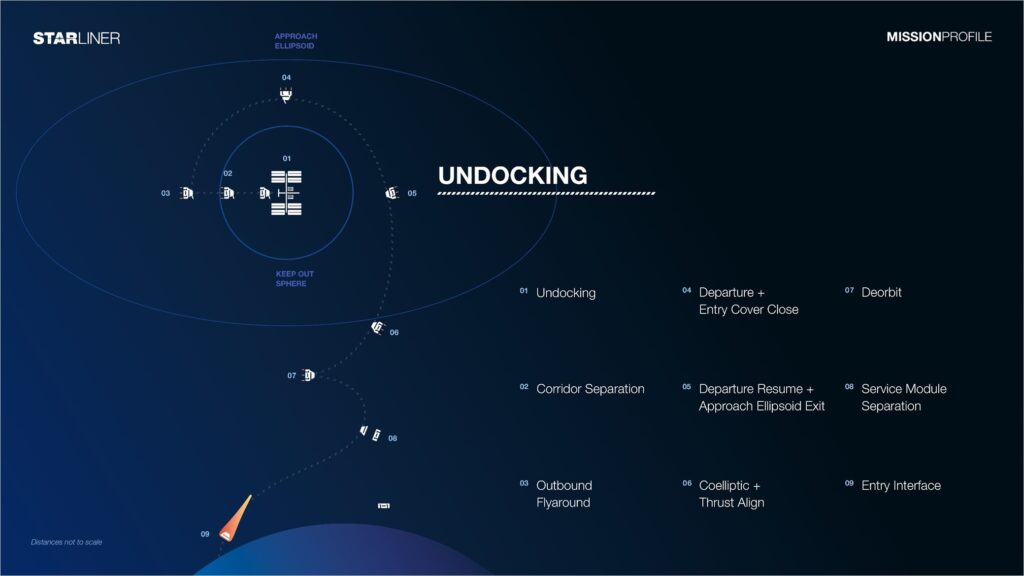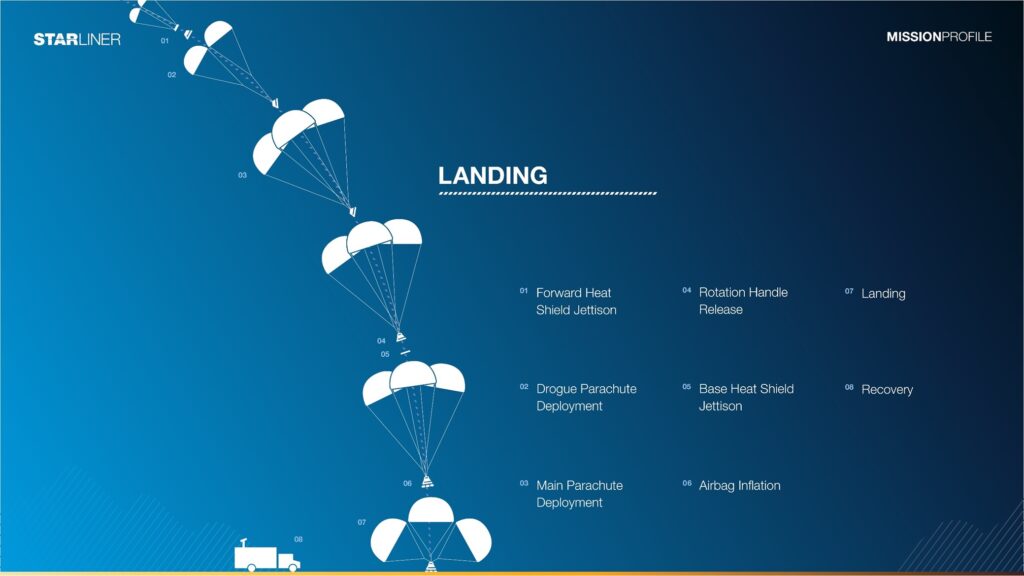Starliner (Boeing)
CFT-1
CFT-1 (Crew Flight Test) 1 Characteristics
- Crew Space Transportation (CST)-100 Boeing Starliner spacecraft (CST-100). Starliner named Calypso.
- Crew Flight Test (Boe-CFT) will be the first crewed mission of the Boeing Starliner (CFT-1) and the third orbital flight test of the Starliner overall.
- Mission: Atlas V launch with Starliner Calypso to the International Space Station.
- Launch location: Space Launch Complex 41, Cape Canaveral Space Force Station, Earth.
- Target orbit: Low Earth Orbit; 72.91-by-181.53 kilometers 51.62 degree inclination.
- Booster: AV-085.
- The Atlas V uses a Centaur-III as its upper stage.
- Configuration: N22 – No fairing, 2 solid rocket motors, and 2 RL10 engines on the Centaur upper stage. “Body Guard”.
- Capsule: Spacecraft 3 (Calypso); 1597d 14h 35min 21s turnaround.
- Capsule history: OFT-1.
- Rocket trajectory: Northeast hugging the east coast of the United States.
- Mission Commander: Butch Wilmore (NASA) – 3rd spaceflight.
- Mission Pilot: Sunita Williams (NASA) – 3rd spaceflight.
- ULA’s 161st launch overall and its 3rd launch of the year.
- Atlas V’s 100th launch, 3rd launch in N22 configuration.
- ULA’s 75th launch from SLC-41, 83rd launch of Atlas V from SLC-41
- 3rd orbital flight of a Starliner spacecraft and 1st human spaceflight by Boeing.
- This mission will bring up to 2 the total of people sent by Boeing to orbit.
CFT-1 Kennedy Space Center - Florida
- Boeing Mission Control Center
- Boeing Pad team:
- ULA Atlas Mission Control Center (White Flight Control Room)
- ULA Pad team:
- NASA Pad team:
- NASA Communications: Derrol Nail (at Hangar AE Control Center). Cape Canaveral Air Force Station (CCAFS) adjacent to KSC.
CFT-1Mission Control Center - Houston (Cape)
Johnson Space Center (Christopher C. Kraft):
- Boeing Mission Director: Leroy Cain
- Flight Director (FD) during ascent: Mike Lammers.
- Launch Director (LD, ULA: Tom Heter III.
- Launch Conductor (LC, ULA: Doug Lebo.
- Capcom: Capsule communicator: Joshua Kutryk (during ascent). The person talking with the astronauts aboard their spacecraft. LC is Loud and Clear. 7 x 24. White Flight Control Room.
- Flight controllers:
- ETHOS: Environmental and Thermal Flight Controller. They are responsible for the space station’s life support systems, including temperature and cooling systems.
- VVO: The visiting vehicle officer monitors the traffic coming and going to International Space Station. The station often receives spacecrafts delivering food and other supplies.
- FDO: The flight dynamics officer plays a key role monitoring the trajectories for NASA’s Orion spacecraft during all phases of its mission to the Moon.
- FAO: The flight activities officers leads is in charge of the schedule. They prepare the timeline for a flight plan to meet mission objectives and any real time changes that need to be made during Artemis missions.
CFT-1 Flight objectives
- 87 test objectives. Based upon space station resources and scheduling needs, a short-duration mission with two astronaut test pilots is sufficient to meet all NASA and Boeing test objectives for CFT, which include demonstrating Starliner’s ability to safely fly operational crewed missions to and from the space station. To protect against unforeseen events with crew transportation to and from the station, NASA may extend the duration of the CFT docking for up to six months.
- Partial manual flight (two hand controllers).
CFT-1 Ascent planning
- Launch Boeing Starliner CST-100 with ULA Atlas V N22.
- Launch date first attempt: 06-05-2024 scrubbed.
- Launch date second attempt: 01-06-2024 scrubbed.
- Launch location: USA Florida, Cape Canaveral Space Force Station, SLC-41 (KSC).
- Flight Control (FC) ISS: Johnson Space Center, Houston, TX.
- Mission Control (MC) Starliner: Johnsen Space Center: Houston TX.
CFT-1 Launch windows
- 06-05-2024 CFT-1 First launch window, scrubbed.
- 01-06-2024 CFT-1 Second launch window, scrubbed.
- 02-06-2024 CFT-1 Third launch window, back-up. Skipped.
- 05-06-2024 CFT-1 Fourth launch window, back-up, wednesday, NET. 10:52 a.m. EDT, 16:52 CEST, launch.
- 06-06-2024 CFT-1 Fifth launch window, back-up.
CFT-1 Preparations
- United Launch Alliance (ULA) uses a unique version of its Atlas V countdown for human spaceflight missions, in the name of safety, to complete hazardous fueling operations and then place the rocket in a quiescent state before the astronauts board.
- The Atlas V launch countdown begins 11 hours and 20 minutes before liftoff and features a four-hour planned, built-in hold at the T-minus four-minute mark for crew ingress into Starliner.
- Overseeing the start of the countdown is the “Preps Team” of console operators inside the Advanced Spaceflight Operations Center. Launch Conductor Dillon Rice will orchestrate the countdown procedures from the Launch Control Center while ULA Launch Director James Whelan is at the helm in the Mission Director’s Center.
- This initial phase of the count will be spent powering up the rocket, running system checkouts, completing standard pre-launch testing and performing final preparations on the rocket and pad systems for propellant-loading operations.
- The Preps Team will lead the countdown through its first five hours, then a shift change occurs to hand each station to the “Tanking & Launch Team” of console operators. These counterparts take responsibilities for the next six hours through liftoff, led by ULA Chief Launch Conductor Doug Lebo and ULA Launch Director Tom Heter.
- The shift handover happens during the planned, hour-long countdown hold at T-minus two hours. Just before the hold concludes, readiness polls are conducted to authorize the start of cryogenic tanking. With the pad cleared of all personnel, the hazardous operation of liquid oxygen and liquid hydrogen filling the Atlas V rocket’s stages for launch is performed.
- Once fueling is completed and the rocket’s tanks placed into stable replenishment, the countdown enters the extended hold at T-minus four minutes. The Blue Team is dispatched to the pad’s 200-foot-tall (61-m) Crew Access Tower (CAT) to ready the White Room and Starliner crew module for arrival of the astronauts, assist the crew into their seats and then close the hatch for flight.
- The team is comprised of eight specialists from ULA and Boeing. Dane Drefke, ULA’s mechanical operations lead engineer serves as the Blue Team Leader (BTL). He is in charge of the Blue Team’s activities and has an obligation to ensure everyone’s safety.
- ULA’s three representatives on the Blue Team begin activities by walking across the 48-foot-long (14.6-m) retractable catwalk extending from the CAT to the White Room. Their duties include verifying the White Room is safe for personnel to enter, establishing access to the capsule, deploying the environmental seal between the pad and spacecraft and setting up access platforms.
- The ULA members then switch places with five Boeing technicians, waiting in the wings on the CAT, led by Boeing’s Pad Team Leader Nate Keyek-Franssen for assisting the crew into the spacecraft.
- The astronauts, commander Butch Wilmore and pilot Suni Williams, receive a final weather briefing and don their spacesuits before leaving NASA’s Crew Quarters in the Neil Armstrong Operations & Checkout Building at the Kennedy Space Center. Departure to board Boeing’s Crew Transport Vehicle (CTV) occurs about three hours and 20 minutes before launch.
- The trip to SLC-41 will take about 25 minutes, with the CTV arriving at the base of the CAT approximately two hours and 55 minutes before launch. The astronauts will take the elevator to Level 12 while the CTV convoy departs the pad and heads to the safe fallback area.
- Once crew ingress is completed, another weather briefing will be held 90 minutes before launch, to inform mission managers that conditions are suitable for the Blue Team to close the Starliner hatch and proceed with the countdown. Pending a go, Boeing technicians will close the hatch and perform cabin leak checks to verify the integrity of the seal.
- AllianceBoeing personnel then depart the White Room so that the ULA technicians can retract access platforms and deflate the environmental seal around the spacecraft to prepare the Crew Access Arm for rotation to the launch position later in the countdown. The entire Blue Team departs the pad about 35 minutes before liftoff.
- The access arm will be hydraulically swung away from the spacecraft 11 minutes prior to launch. The process will take about two minutes to reach the stowed position against the CAT. If the need arises, the arm can be redeployed in less than 15 seconds by dropping counterweights.
- Seven minutes before launch, Lebo performs the readiness polling of the launch team members, Ascent Flight Director Mike Lammers in Houston and the Starliner crew before Heter gives final permission to launch. The countdown clocks resume four minutes before liftoff to put the rocket on internal power, pressurize its tanks, arm systems and start the main engine.
- The daily available launch window is instantaneous, meaning there is only an instant in time each day for launch to occur. This split second happens when the orbital plane of the International Space Station passes over the launch pad, thereby enabling Atlas V to put Starliner on the proper trajectory to intercept the station for rendezvous and docking.
- The main engine and twin solid rocket boosters generate 1.6 million pounds (7.1 mega-Newtons) of thrust to begin the voyage of Wilmore and Williams. The commander will call out “roll program” as Atlas V clears the tower to place the astronauts heads-up for their ride to space.
- The main engine will ease back for a period of deep throttling, going into its throttle bucket during the region of maximum aerodynamic stresses on the rocket in the dense lower atmosphere and to lessen the G-loads on the crew.
- The solid rocket boosters burn for a minute-and-a-half, followed by the main engine revving back to full throttle, to triple the rocket’s velocity through the remaining first stage of flight.
- Just over two minutes after liftoff, Atlas V will have burned nearly 500,000 pounds (227,000 kg) of fuel and weigh only half of what it did at launch.
- Following the first stage engine shutdown, the Atlas V common core booster will jettison from the Centaur four minutes and 35 seconds after liftoff. The Centaur ignites both engines 10 seconds later at an altitude of approximately 60 nautical miles (111 km).
- The Centaur burn will last just over seven minutes to deliver Starliner at the desired injection point for separation at T+plus 14 minutes, 55 seconds into a 98 by 39-nautical mile (181×72-km) suborbital trajectory, inclined 51.6 degrees relative to the equator.
- Atlas V will launch northeasterly from Cape Canaveral, paralleling the Eastern Seaboard and crossing the North Atlantic to accelerate Starliner to 17,475 mph (28,123 kmph).
- For Starliner missions, Atlas V takes a special trajectory to space that requires the Centaur upper stage to use two engines instead of one. The double-engine configuration allows the rocket to fly a flatter trajectory and ensure the spacecraft can execute an abort at any time to bring the astronauts back to Earth safely if a problem occurs.
- Dual Engine Centaur also enables the customized flight profile for Starliner that features just a single burn and a limited acceleration rate to manage the G-force experienced by the astronauts aboard.
- After Centaur releases Starliner, the spacecraft employs the same operational procedure as the space shuttle, which also launched on suborbital trajectories, by performing an orbital-maneuvering engine firing to reach a stable orbit about 15 minutes after separation.
- Following separation from Atlas V, Starliner engines will burn taking it the rest of the way to orbit and on to the International Space Station. CFT is ULA’s first human launch. Liftoff will occur from Space Launch Complex-41 at Cape Canaveral Space Force Station, Florida.
- On the shoulders of Atlas, Boeing’s CST-100 Starliner spacecraft will soon launch two NASA astronauts on the Crew Test Flight (CFT) to the International Space Station for NASA’s Commercial Crew Program
- United Launch Alliance (ULA) is readying the Atlas V rocket for the historic flight test that is targeted for launch on May 6 from Space Launch Complex-41 at Cape Canaveral Space Force Station in Florida.
- Astronauts Butch Wilmore and Suni Williams will be the first crew members to fly aboard Starliner. Wilmore, the CFT commander, is a retired U.S. Navy captain and veteran of two previous spaceflights to the space station. Williams, serving as the CFT pilot, is also a retired Navy captain and veteran of two previous spaceflights as a long-duration resident aboard the orbiting laboratory.
CFT-1 Ascent sequence of events
- T-hh:mm:ss
- T-48:00:00 Roll-out to the pad.
- T-48:00:00 Crew arrival at KSC.
- T-24:00:00 RP1 rocket fueling of the first stage (non cryo).
- T-11:20:00 Countdown begins.
- T-10:00:00 Weather briefing. (US Space Force’s 45th Weather Squadron).
- T-00:00:00 Go/No Go for tanking.
- T-00:00:00 Atlas V tanking (01). Flow rate.
- T-08:00:00 Medical checks astronauts.
- T-04:00:00 Weather briefing:
- 10% change of violation.
- 10-15 mps ESE.
- Cumulus.
- T-03:55:00 Powering up ground systems.
- T-03:50:00 Powering up launch vehicle.
- T-03:50:00 Pressurization for flight.
- T-03:50:00 Crew suited up in quarantine facility at KSC.
- T-03:50:00 Readiness check.
- T-03:45:00 Blue team (5 people from Boeing and 3 from ULA) arriving at the pad.
- T-03:40:00 Weather briefing:
- Possible cumulus around the launch pad during launch. Risk of lightning.
- Low risk at the ascent abort corridor.
- T-03:43:00 Suit leak check (large).
- T-03:34:00 Com checks.
- T-03:33:00 Crew card game (prelaunch tradition, slack time).
- T-03:24:00 Crew walkout of the Neil Armstrong Operations and Checkout Building.
- T-03:20:00 Crew takes Boeing Astrovan II to the launch pad. Plate RYD2SPC.
- T-03:03:00 Crew arrival at the pad.
- T-02:54:00 Crew up the tower. Restroom breaks. Walk through Crew Access Arm to the White Room (clean room).
- T-02:49:00 Commander enters Starliner. Settled in (takes 15-20 mins, ingress). 85 switches on the console. Com check (ATG1 and ATG2, Air To Ground). Suit leak check (small).
- T-02:30:00 Pilot enters Starliner.
- T-02:10:00 Visors up.
- T-02:00:00 Weather briefing.
- 80 F
- Light wind.
- Coastal showers south of the space coast at a sufficient distance at this time.
- Cumulus cloud rule.
- 90% Go at T-0.
- T-01:56:00 Removal hatch frame. Seals checks with black light.
- T-01:48:00 Hatch closure start (02).
- T-01:40:00 Hatch closure complete.
- T-01:30:00 Gravity indicator secure test (seat no. 2).
- T-01:19:00 Cabin Leak Checks (03). Pressure increases. Warning for audible testing noise.
- T-00:50:00 Blue Team Boeing leaves the white room and the pad.
- T-00:37:00 Blue Team ULA leaves the pad.
- T-00:35:00 LC Com checks (capcom/crew).
- T-00:33:00 Tower closeout.
- T-00:30:00 LD Countdown checks.
- T-00:20:00 Visors down and air flow settings by the astronauts.
- T-00:17:00 FD Prelaunch checks (range, charging, weather).
- T-00:11:00 Crew Access Arm Retraction (CAA, 04). Takes 2 mins. Re-deploy can be done in 15 secs by using a counterweight. Stowed for launch.
- T-00:07:00 LC Poll Go/No Go for launch. Channel 1, See image of the checklist below. Launch vehicle system poll. Status check. Conducted by LC (Chuck Lebo). LD gets permission to launch.
- T-00:07:00 Clocks are synchronized.
- T-00:07:00 Internal power (battery). 4 minutes to put the rocket on internal power.
- T-00:06:00 Terminal count.
- T-00:01:15 Launch Abort System (LAS) activated. To Auto.
- T+00:00:00:00 Liftoff (05). Switch to MET.
- T+00:00:00:00 Liftoff (05). Switch to MET (T+dd:hh:mm:ss).
- T+00:00:00:12 Roll program.
- T+00:00:00:40 Maximum Dynamic Pressure (Max Q)(06). Until T+00:00:00:85.
- T+00:00:00:95 Solid rocket booster (SRB) burnout.
- T+00:00:02:40 Solid Rocket Booster (SRB) Jettison (07).
- T+00:00:04:30 Booster Engine Cutoff (BECO)
- T+00:00:04:35 Booster Separation (08).
- T+00:00:00:00 Ascent Cover Jettison (09).
- T+00:00:04:45 Centaur Ignition (10).
- T+00:00:05:05 Aeroskirt Jettison (11).
- T+00:00:12:00 Main Engine Cutoff (MECO) (12).
- T+00:00:15:00 Spacecraft Separation (13).
- T+00:00:31:00 Orbital Insertion Burn (14). Time of Ignition (TIG), Orbital Insertion maneuver for rendezvous with ISS. Push up. OI burn was 43 secs. Ascent profile complete.
CFT-1 Docking
- NHPC-1 burn. Two NHPC burns help set the spacecraft up for favorable lighting and relative position conditions for final rendezvous, proximity operations and docking.
- NHPC-2 burn.
- NHRPC. Rendezvous.
- TPI.
- IF 1 (Inbound Flyaround 1) burn.
- IF 2 (Inbound Flyaround 2) burn. 1 seconde.
- ACI (Approach Corridor Initiation) burn. Demo manual control.
- VESTA2: Vision-based Electro-Optical Sensor Tracking Assembly.
- LADAR.
- KOS = Keep Out Sphere.
- T+dd:hh:mm:ss Height Adjustment + Plane Change (01)
- T+dd:hh:mm:ss Height Adjustment + Plane Change (02)
- T+dd:hh:mm:ss Coelliptic Plane Change (03)
- T+dd:hh:mm:ss Terminal Phase Initiation Burn + Approach Ellipsoid Entry (04)
- T+dd:hh:mm:ss Inbound Flyaround 1 (05)
- T+dd:hh:mm:ss Inbound Flyaround 2 (06)
- T+dd:hh:mm:ss Corridor Approach (07)
- T+dd:hh:mm:ss 250-Meter Hold + Resume Approach (08)
- T+dd:hh:mm:ss 200-Meter Retreat + Keep Out Sphere Entry (09)
- T+dd:hh:mm:ss 10-Meter Hold + Final Approach (10)
- T+dd:hh:mm:ss Docking (11)
- 26 hours after launch.
- 06-06-2024 CFT-1 Docking ISS at 12:15 p.m. EST (16:15 CEST)
- 06-06-2024 CFT-1 Hatch opening and welcome by ISS Expedition 71 crew at 1:30 p.m. EST (17:30 CEST).
CFT-1 On-orbit flight test objectives
- Vestibule pressurization, hatch open & joint ventilation with ISS
- Recharge Starliner batteries
- Verify docked telemetry paths & file transfer
- Initialize Starliner navigation systems from ISS
- Conduct audio checkouts
- Transfer cargo to/from ISS
- Conduct pre-undock systems activation and checkout
- Safe haven demonstration
CFT-1 Docked program
- 05-06-2024 Flight Day 1, Docked Day 0: Launch.
- 06-06-2024 Flight Day 2, Docked Day 1: Docking, hatch opening and unloading cargo.
- 07-06-2024 Flight Day 3, Docked Day 2:
- Safe haven demonstration
- Live Starliner tour
- Housekeeping
- Habitability assessment
- Starliner enters quiescent mode
- 08-06-2024 Flight Day 4, Docked Day 3:
- Downlinked free-flight telemetry and VESTA files
- Window cover installation
- Service Module battery checkout
- Dry run of undock vehicle power-up and propulsion system checkout procedures
- Landing set for no earlier than 18-06-2024
- 09-06-2024 Flight Day 5, Docked Day 4: Loading cargo.
- 02-07-2024 Undocking NET.
CFT-1 Undocking
- T+dd:hh:mm:ss Undocking (01)
- T+dd:hh:mm:ss Corridor Separation (02)
- T+dd:hh:mm:ss Outbound Flyaround (03)
- T+dd:hh:mm:ss Departure + Entry Cover Close (4)
- T+dd:hh:mm:ss Departure Resume + Approach Ellipsoid Exit (05)
- T+dd:hh:mm:ss Coelliptic + Thrust Alighn (06)
- T+dd:hh:mm:ss Deorbit (07). Four MAG thrusters for 55 seconds.
- T+dd:hh:mm:ss Service Module Separation (08)
- T+dd:hh:mm:ss Entry Interface (09)
CFT-1 Landing
- T+dd:hh:mm:ss Forward Heat Shield Jettison (01)
- T+dd:hh:mm:ss Drogue Parachute Deployment (02)
- T+dd:hh:mm:ss Main Parachute Deployment (03)
- T+dd:hh:mm:ss Rotation Handle Release (04)
- T+dd:hh:mm:ss Base Heat Shield Jettison (05)
- T+dd:hh:mm:ss Airbag Inflation (06)
- T+dd:hh:mm:ss Landing (07)
- T+dd:hh:mm:ss Recovery (08)
- White Sands, NM
Starliner
Functionality Crew Module (CM) CST-100
- Starliner is designed for compatiblity with Atlas V (ULA), Delta IV (ULA), Vulcan Centaur (ULA) and Falcon 9 (SpaceX).
- Low orbit and ISS.
- Crew capacity up to 7.
- Can re boost ISS (now done by Soyuz and Progress).
- Parachute and airbag system.
- Can land on land and or water (in case of emergency). Crew Dragon: Can land on water only. Salt water adds complexity to refurbishment.
- Easy recovery.
- Relatively clean vehicle when landed.
- Easy path to refurbishment and re usability.
- Turn around in 6 months.
- Re usability 10 times.
- Starliner follows a sub-orbital trajectory first to be able to stay in contact with the crew all the time.
- Starliner has a manual backup system which can be used by the crew at any time they want. All the way to a safe landing.
Characteristics CST-100
- 439,000 lb thrust launch aboard engines.
- 24 x 1,500 lb thrust orbital maneuvering and attitude control thrusters.
- 28 x 100 lb thrust Reaction Control System (RCS) can reboost ISS No reboosting ISS.
Back shell Starliner (Boeing)
- The back shell of the Starliner space craft is covered with a composite material (porous carbon Matrix). During reentry it will heat up, break down and later release gas. The shield is light weight. (no tiles). Non-ablative heat shields dont’t break down at the same time meaning they’re easy to reuse but theay are heavier because they are thicker and they are also harder to work with. Another disadvantage is that they would lose tiles and break them all the time. To handle this Boeing uses the ablative heat shield for the main area where it gets the most heating and uses the non-ablative one on the backshell.
Back shell Crew Dragon (SpaceX)
- SpaceX uses Pika X (phenolic impregnated carbon ablator (1 piece, reusable) on the Crew Dragon back shell. Additionally SpaceX uses SPAM (SpaceX Proprietary Ablative Material). After each flight Pika X and SPAM are removed and replaced.
Landing vehicles
- On the edge of the landing zone is a Mobile Tracking Vehicle (MBTV).
- On the edge of the landing zone is a Mobile Landing Control Center (MLCC).
- On the edge of the landing zone are Recovery Vehicles (RV).
Starliner progress
- 00-09-2015 Starliner name unveiled
- 00-08-2016 Crew access arm installed
- 00-08-2016 Drop tests
- 00-10-2016 Engine tests
- 00-01-2017 Spacesuit reveal
- 00-03-2017 Boeing mission simulator installed
- 00-03-2017 Parachute drop test
- 00-05-2017 Seat drop tests
- 20-12-2019 OFT-1 (OFT1). Test objectives achieved:
- Space to space communication.
- Startracker alignment using Vista navication systems.
- Extended an retrackted NASA docking system.
- Rosie (ATD) Data collection.
- Abort burn capability (needed for proximity operations with ISS.
- 19-05-2022 OFT-2 (OFT2). ULA Atlas V, SLC-41.
- 03-11-2022 Suited EMER SIM Operations in the Boeing Starliner spacecraft simulator at NASA’s Johnson Space Center.
- 00-07-2023 CFT-1 Delayed. Problems with the suspension lines on Starliner’s main parachutes and much of the capsule’s wiring was wrapped with flammable tape.
- 18-03-2024 CFT-1 Two weeks fuel load test.
- 16-04-2024 CFT-1 Rollout Capsule and Service Module from Boeing’s Commercial Crew and Cargo Processing Facility (C3PF) to ULA’s Vertical Integration Facility at Space Launch Complex 41 (SLC-41). There Starliner will be lifted onto the Atlas V followed by a dry run with the crew and rollout to the pad.
- 02-05-2024 CFT-1 In preparation for the arrival of NASA’s Boeing Crew Flight Test, four crew members aboard the International Space Station relocated the SpaceX Dragon crew spacecraft to a different docking port. Dragon port relocation sequence of events (ISS Harmony port 2 to ISS Harmony port 3). See SpaceX Falcon 9, Crew Dragon and Falcon Heavy sequence of events
- 04-05-2024 CFT-1 Rollout. A United Launch Alliance Atlas V rocket, topped with the Boeing Starliner spacecraft, rolls out to its launch pad at Cape Canaveral Space Force Station on May 4, 2024.
- 06-05-2024 CFT-1 Scrubbed. 10:34 p.m. (04:34 CEST) Launch. Scrubbed two hours before liftoff time. Atlas V valve issue. Buzzing liquid oxygen pressure relief velve on the upper stage. Rapidly opening and closing repeatedly. While ULA has seen the valve issue on previous uncrewed satellite launches, the flight rules for Starliner’s crewed test forbid cycling the valve to fix it with astronauts aboard. If the wonky valve needs to be replaced, the earliest Starliner could launch its Crew Flight Test mission would be Sunday, May 12, Bruno said. If not, the mission could potentially aim for Tuesday, May 7, at 10:11 p.m. ET or Friday, May 10, at 9 pm ET.Engineers are expected to know more on the road ahead for Starliner and the Atlas V early Tuesday.
- 07-05-2024 CFT-1 Rollback.14-05-2024 CFT-1 Four extra days delay to give engineers time to make sure a Starliner Helium leak in the crew ship’s propulsion system has been resolved. The Helium leak in the Starliner’s propellant pressurization system was noted during the countdown last week, but it remained within safe limits for flight. After the Atlas 5 and Starliner were rolled back to the VIF for the oxygen valve replacement, managers decided to take a closer look at the Helium issue. The leak was detected in plumbing making up a Helium manifold inside one of four “doghouse” assemblies spaced around the exterior of the Starliner’s drum-shaped service module. Each doghouse features four Orbital Maneuvering and Attitude Control (OMAC)-thrusters and four small reaction control system maneuvering jets. Pressurized Helium gas is used to push propellants to the rocket motors in each doghouse, as well as four powerful motors at the base of the spacecraft that would be used during an in-flight abort to propel the capsule away from a malfunctioning booster. The leak was traced to a flange on a single RCS thruster. Bolts were retorqued and engineers believe the system is flight ready. But managers decided to pressurize the Helium lines throughout the spacecraft so engineers can monitor them over time to make sure the lines are, in fact, leak free or within acceptable limits. As a part of the testing, Boeing will bring the propulsion system up to flight pressurization just as it does prior to launch, and then allow the Helium system to vent naturally to validate existing data and strengthen flight rationale, the company said in a statement
- 30-05-2024 CFT-1 Rollout (second time).
- 31-05-2024 CFT-1 Pre-launch new conference:
- NASA: Extra Urine pump cargo for ISS added, 2 cases with generic supply taken off. Crew has been home a few days. 31-05-2024 crew is back on the pad for the first since the scrubbed flight at 06-05-2024. Landing not in exclusion zone in the Atlantic (cold and waves). Shannon in Ireland is alternative.
- Boeing/Starliner: A slight Helium leak in a thruster of the Service Module (SM). Accepted.
- ULA: Seal fixed. Helium leak is save to fly.
- ISS: Urine pump broken.
- Weather: 90% favorable at the moment for both 01-06-2024 and 02-06-2024.
- 01-06-2024 CFT-1 Valve communication issues with Atlas V’s ground systems was temporarily lost about two hours before the scheduled liftoff. Glitch resolved in time.
- 01-06-2024 CFT-1 Commander reported a fan warning light in his spacesuit with less than 11 minutes to launch. Visor up. To redundant mode. Visor down. Glitch resolved in time.
- 01-06-2024 CFT-1 Ground Launch Sequencer (GLS) computer triggered an automatic abort 3 minutes and 50 seconds before liftoff. Power to external, crew access arm deploy. Team saving the vehicle to a save configuration.
- 01-06-2024 CFT-1 Scrubbed.
- 01-06-2024 CFT-1 Engineers suspect the abort may have been caused by a faulty computer card in the ground launch sequencer system housed in a building at the base of Starliner’s launch pad, Launch Complex-41, at Cape Canaveral Space Force Station. But checking that card would require ground teams to wait several hours until it was safe to approach the pad. “The system was unsuccessful in verifying the sequencer’s necessary
redundancy,” NASA officials said of the sequencer glitch. - 01-06-2024 CFT-1 “We can’t get in there until we’re done defueling a rocket, which is followed by making sure there’s no stray hydrogen inside that building, so that it’s safe for people to be there. Then we’ll go in and troubleshoot it, Tony Bruno (CEO ULA) said. “And if it’s as simple as replacing a card, we have spares for everything, and we would do that. We would test it, which is required, and then be in a position for a recycle tomorrow.”
- 02-06-2024 CFT-1 Skip window to assess a ground support equipment issue.
- 05-06-2024 CFT-1 Launch.
- 06-06-2024 CFT-1 The cooling system using more water than expected. The astronauts refilled the water tank in their cooling system from an onboard supply and future vehicles will carry a bigger tank from the start, Boeing said. The water cooling system glitch, for one, is strikingly similar to one NASA faced on shuttle flights.
- 06-06-2024 CFT-1 Controllers found workarounds for two new Helium leaks. Helium is used for the fuel lines of the thrusters.
- 06-06-2024 CFT-1 Five aft thrusters on the Starliner service module go offline.
- 06-06-2024 CFT-1 Starliner docked at the ISS just over an hour later than planned after some manual flying by NASA astronauts Butch Wilmore (commander) and Sunita Williams (pilot) helped Boeing engineers recover four of the five down thrusters. The fifth will stay deactivated for the rest of the mission, but the glitch — which may actually be in Starliner’s software and not the thrusters themselves — won’t pose a risk for the return to Earth. ISS flight controllers can use the station’s robotic arm cameras to inspect the affected thrusters on Starliner in case any issues can be detected that way. Since the thrusters are on Starliner’s service module, which is jettisoned ahead of reentry, Boeing won’t get it back to study on Earth. During Boeing’s second uncrewed flight test several thrusters also went offline in much the same way. The ones affected in the 2022 flight performed fine after being recovered.
- 06-06-2024 CFT-1 Another new Helium leak detected after Starliner docked with the space station. Starliner has an ample supply of the gas for the rest of the mission, but Boeing engineers still want to understand why they keep popping up.
- 06-06-2024 CFT-1 Boeing: “We have two problems on this vehicle right now, the Helium leak and figuring out how to fine-tune these thrusters so they’re not selected off”.
- 07-06-2024 CFT-1 Wilmore and Williams have a packed week or more while at the space station, where they will test everything from how comfortable Starliner is to sleep and how well it can accommodate crews of four astronauts (its nominal complement) to how the capsule serves as a safe haven in case of a station emergency.
- 15-06-2024 Testing in orbit was unable to find the root cause of the issues.
- 18-06-2024 NASA announced that Starliner will conclude its first human mission to the International Space Station (ISS) no earlier than June 26, nearly three weeks after it launched.
- 18-06-2024 The mission was originally supposed to spend about a week at the ISS, but its ISS departure has been pushed back considerably. NASA and Boeing are using the extra time to continue evaluating thruster issues that interfered with Starliner’s first ISS docking attempt on June 6. Additionally, a postponed ISS maintenance spacewalk will now take place on June 24, two days before Starliner’s scheduled departure.
- 18-06-2024 Stich reiterated that five of Starliner’s 28 reaction control thrusters failed during the final phase of the ISS rendezvous on June 6, though four of them eventually came back online. (Starliner succeeded on its second docking try, which occurred several hours later on June 6.) Evaluation of what happened is ongoing. As part of that effort, Boeing and NASA ground team members performed a thruster hot-fire test over the weekend alongside the astronauts, and, after that, Stich said, everyone “feels very confident.”
- 18-06-2024 One thruster was not fired during the test due to abnormally low pressure first observed during docking, and it will remain offline during the return to Earth. (Canadarm2, the robotic arm on the space station, was also used to view the thrusters via robotic camera, according to ISS Program Manager Dana Weigel, who also participated in the teleconference.)
- 24-06-2024 The issues with the Helium and the thrusters take place in the Service Modules (SM). Since the SM is jettisoned during the return journey, research is only possible as long as Starliner is docked to the ISS.
28-06-2024 Some progress has been made: the helium leaks have stabilized, and all but one of the errant thrusters is rated for use to come back to Earth. Starliner has 28 thrusters altogether in its RCS; five were misbehaving, and of those five, only one will be taken offline during undocking. Aerojet Rocketdyne’s Reaction Control System (RCS) engines.
01-07-2024 Capsule is performing well enough that it will likely be able to stay in orbit beyond the initially envisioned 45-day limit, NASA says.
02-07-2024 Start of ground testing of Starliner’s thruster system.
Footnotes

